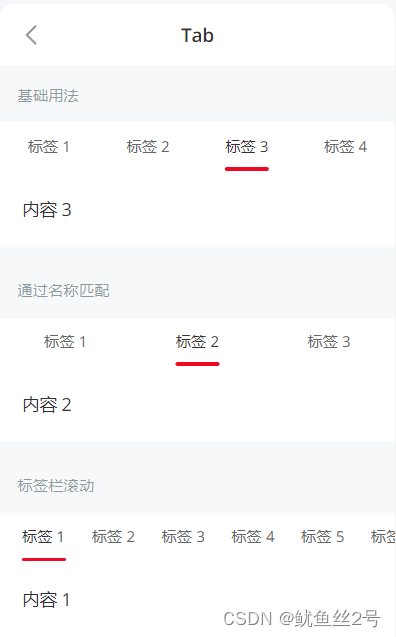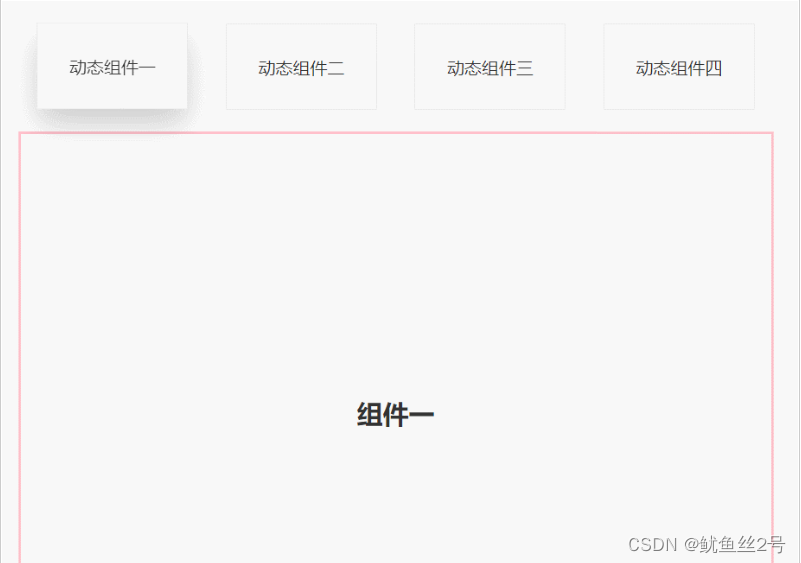vue使用動態組件實現TAB切換效果完整實例
一、方法1:使用Vant組件庫的tab組件
Vant 2 – Mobile UI Components built on Vue

二、 方法2:手動創建tab切換效果


1.在components文件夾下創建切換的.vue頁面、引入使用
import one from "./components/one";
import two from "./components/two";
import three from "./components/three";
import four from "./components/four";
components: {
one,
two,
three,
four,
},
2.佈局:上面放tab點擊的標簽,下面放組件呈現對應內容
// 然後使用v-for循環出來呈現
<template>
<div id="app">
<div class="top">
<!-- 放置tab點擊標簽 -->
<div class="crad"
:class="{ highLight: whichIndex == index }"
v-for="(item, index) in cardArr"
:key="index"
@click="whichIndex = index">
{{ item.componentName }}
</div>
</div>
<div class="bottom">
<!-- 放置動態組件... -->
<!-- keep-alive緩存組件,這樣的話,組件就不會被銷毀,DOM就不會被重新渲染,
瀏覽器也就不會回流和重繪,就可以優化性能。不使用的話頁面加載就會慢一點 -->
<keep-alive>
<component :is="componentId"></component>
</keep-alive>
</div>
</div>
</template>
3.寫好上面的tab點擊標簽,定義數據修改樣式
// 首先我們在data中定義數組cardArr存放點擊tab的數據
data() {
return {
whichIndex: 0,
cardArr: [
{
componentName: "動態組件一",
componentId: "one",
},{
componentName: "動態組件二",
componentId: "two",
},{
componentName: "動態組件三",
componentId: "three",
},{
componentName: "動態組件四",
componentId: "four",
},
],
};
},
// 又因為需要有高亮狀態樣式:默認索引0高亮
.highLight {
box-shadow: 0 15px 30px rgba(0, 0, 0, 0.2);
transform: translate3d(0, -1px, 0);
}
三、完整代碼
<template>
<div id="app">
<div class="top">
<div
class="crad"
:class="{ highLight: whichIndex == index }"
v-for="(item, index) in cardArr"
:key="index"
@click="
whichIndex = index;
componentId = item.componentId;
"
>
{{ item.componentName }}
</div>
</div>
<div class="bottom">
<keep-alive>
<component :is="componentId"></component>
</keep-alive>
</div>
</div>
</template>
<script>
import one from "./components/one";
import two from "./components/two";
import three from "./components/three";
import four from "./components/four";
export default {
components: {
one,
two,
three,
four,
},
data() {
return {
whichIndex: 0,
componentId: "one",
cardArr: [
{
componentName: "動態組件一",
componentId: "one",
},
{
componentName: "動態組件二",
componentId: "two",
},
{
componentName: "動態組件三",
componentId: "three",
},
{
componentName: "動態組件四",
componentId: "four",
},
],
};
},
};
</script>
<style lang="less" scoped>
#app {
width: 100%;
height: 100vh;
box-sizing: border-box;
padding: 50px;
.top {
width: 100%;
height: 80px;
display: flex;
justify-content: space-around;
.crad {
width: 20%;
height: 80px;
line-height: 80px;
text-align: center;
background-color: #fff;
border: 1px solid #e9e9e9;
}
.highLight {
box-shadow: 0 15px 30px rgba(0, 0, 0, 0.2);
transform: translate3d(0, -1px, 0);
}
}
.bottom {
margin-top: 20px;
width: 100%;
height: calc(100% - 100px);
border: 3px solid pink;
display: flex;
justify-content: center;
align-items: center;
}
}
</style>
總結
到此這篇關於vue使用動態組件實現TAB切換效果的文章就介紹到這瞭,更多相關vue動態組件實現TAB切換內容請搜索WalkonNet以前的文章或繼續瀏覽下面的相關文章希望大傢以後多多支持WalkonNet!
推薦閱讀:
- vue使用動態組件實現TAB切換效果
- vue子路由跳轉實現tab選項卡效果
- vue中activated的用法
- Vue動態組件和keep-alive組件實例詳解
- vue項目兩種方式實現豎向表格的思路分析